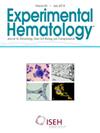人胎儿肝脏造血干细胞选择性表达CD49f。
IF 2.1
4区 医学
Q2 HEMATOLOGY
引用次数: 0
摘要
鉴定人类造血细胞的表型,这些细胞在体外显示出长期的成熟细胞输出,并在免疫缺陷小鼠中重新繁殖,对于预测在物理或基因操作之前或之后新鲜收获的骨髓或脐带血的治疗潜力非常重要。然而,表征它们的关键特性和从多种来源分离它们以提高细胞纯度的策略,并阐明调节它们维持成熟血细胞产生能力的机制仍然是主要的兴趣。先前的研究表明,具有长期血细胞输出潜力的胎儿和成人细胞在发育保存的CD45+CD34+CD38-CD45RA-CD90+群体中各自的GPI80+和CD49f+亚群中高度富集。在妊娠早期人类胎儿肝脏中发现的所谓的“GPI80”造血细胞特别令人感兴趣,因为与成人甚至新生儿(脐带血)相比,它们具有非常高的再生能力。“CD49f”同行。在这里,我们假设GPI80+细胞的高再生活性可以在CD49f+亚群中进一步增强。我们现在证明,在GPI80+群体中,CD49f的共表达确定了一个亚群,该亚群在半固体培养基中短期髓系集落形成活性降低,在12周补充生长因子的基质共培养和移植的免疫缺陷小鼠中,后代产量更高。这些发现表明CD49f是人类造血干细胞在个体发育和衰老过程中的普遍标记。本文章由计算机程序翻译,如有差异,请以英文原文为准。
Hematopoietic stem cells in human fetal liver selectively express CD49f
Identification of phenotypes of human hematopoietic cells that display long-term mature cell outputs in vitro and repopulating capability in immunodeficient mice has been important to anticipating the therapeutic potential of fresh harvests of bone marrow or cord blood before or after their physical or genetic manipulation. However, characterizing their key properties and strategies for their isolation from multiple sources at increasing cell purities and elucidating the mechanisms that regulate their ability to sustain mature blood cell production continues to be of major interest. Previous studies have shown that fetal and adult human cells with long-term blood cell output potential are highly enriched in their respective glycosylphosphatidylinositol (GPI)-anchored surface protein GPI80+ and CD49f+ subsets of a developmentally preserved CD45+CD34+CD38−CD45RA−CD90+ population. The so-called “GPI80” hematopoietic cells found in first-trimester human fetal liver are of particular interest because of their very high regenerative capability compared with their adult or even neonatal (cord blood) “CD49f” counterparts. Here, it was hypothesized that high regenerative activity of the GPI80+ cells could be further enriched within a CD49f+ subset. We now demonstrated that coexpression of CD49f within the GPI80+ population identifies a subset with reduced short-term myeloid colony-forming activity in semisolid medium and greater progeny outputs in both 12-week growth factor-supplemented stromal cocultures and in transplanted immunodeficient mice. These findings demonstrated that CD49f is a pervasive marker of human hematopoietic stem cells (HSCs) throughout ontogeny and aging.
求助全文
通过发布文献求助,成功后即可免费获取论文全文。
去求助
来源期刊

Experimental hematology
医学-血液学
CiteScore
5.30
自引率
0.00%
发文量
84
审稿时长
58 days
期刊介绍:
Experimental Hematology publishes new findings, methodologies, reviews and perspectives in all areas of hematology and immune cell formation on a monthly basis that may include Special Issues on particular topics of current interest. The overall goal is to report new insights into how normal blood cells are produced, how their production is normally regulated, mechanisms that contribute to hematological diseases and new approaches to their treatment. Specific topics may include relevant developmental and aging processes, stem cell biology, analyses of intrinsic and extrinsic regulatory mechanisms, in vitro behavior of primary cells, clonal tracking, molecular and omics analyses, metabolism, epigenetics, bioengineering approaches, studies in model organisms, novel clinical observations, transplantation biology and new therapeutic avenues.
 求助内容:
求助内容: 应助结果提醒方式:
应助结果提醒方式:


